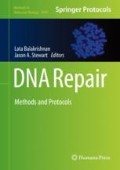Abstract
Four-stranded G-quadruplexes consists of tracks of guanines that are stabilized by Hoogsteen base pairing. The formation of G-quadruplexes in genomic DNA contribute to numerous biological processes in vivo, including replication, transcription, and telomere maintenance. Here, we present a detailed method to detect the colocalization of G-quadruplexes with telomeres in vivo, using the BG4 antibody developed from Dr. Shankar Balasubramanian’s lab.
Access this chapter
Tax calculation will be finalised at checkout
Purchases are for personal use only
References
Lipps HJ, Rhodes D (2009) G-quadruplex structures: in vivo evidence and function. Trends Cell Biol 19(8):414–422. https://doi.org/10.1016/j.tcb.2009.05.002
Li W, Wu P, Ohmichi T, Sugimoto N (2002) Characterization and thermodynamic properties of quadruplex/duplex competition. FEBS Lett 526(1–3):77–81
Bochman ML, Paeschke K, Zakian VA (2012) DNA secondary structures: stability and function of G-quadruplex structures. Nat Rev Genet 13(11):770–780. https://doi.org/10.1038/nrg3296
Rhodes D, Lipps HJ (2015) G-quadruplexes and their regulatory roles in biology. Nucleic Acids Res 43(18):8627–8637. https://doi.org/10.1093/nar/gkv862
Bugaut A, Balasubramanian S (2012) 5′-UTR RNA G-quadruplexes: translation regulation and targeting. Nucleic Acids Res 40(11):4727–4741. https://doi.org/10.1093/nar/gks068
Beaudoin JD, Perreault JP (2013) Exploring mRNA 3′-UTR G-quadruplexes: evidence of roles in both alternative polyadenylation and mRNA shortening. Nucleic Acids Res 41(11):5898–5911. https://doi.org/10.1093/nar/gkt265
Balasubramanian S, Neidle S (2009) G-quadruplex nucleic acids as therapeutic targets. Curr Opin Chem Biol 13(3):345–353. https://doi.org/10.1016/j.cbpa.2009.04.637
Buket O, Clement L, DanZhou Y (2014) DNA G-quadruplex and its potential as anticancer drug target. Sci China Chem 57(12):1605–1614. https://doi.org/10.1007/s11426-014-5235-3
Zahler AM, Williamson JR, Cech TR, Prescott DM (1991) Inhibition of telomerase by G-quartet DNA structures. Nature 350(6320):718–720. https://doi.org/10.1038/350718a0
Huppert JL, Balasubramanian S (2005) Prevalence of quadruplexes in the human genome. Nucleic Acids Res 33(9):2908–2916. https://doi.org/10.1093/nar/gki609
Balasubramanian S, Hurley LH, Neidle S (2011) Targeting G-quadruplexes in gene promoters: a novel anticancer strategy? Nat Rev Drug Discov 10(4):261–275. https://doi.org/10.1038/nrd3428
Besnard E, Babled A, Lapasset L, Milhavet O, Parrinello H, Dantec C, Marin JM, Lemaitre JM (2012) Unraveling cell type-specific and reprogrammable human replication origin signatures associated with G-quadruplex consensus motifs. Nat Struct Mol Biol 19(8):837–844. https://doi.org/10.1038/nsmb.2339
de Lange T (2002) Protection of mammalian telomeres. Oncogene 21(4):532–540. https://doi.org/10.1038/sj.onc.1205080
Podlevsky JD, Chen JJ (2012) It all comes together at the ends: telomerase structure, function, and biogenesis. Mutat Res 730(1–2):3–11. https://doi.org/10.1016/j.mrfmmm.2011.11.002
Blackburn EH, Greider CW, Szostak JW (2006) Telomeres and telomerase: the path from maize, Tetrahymena and yeast to human cancer and aging. Nat Med 12(10):1133–1138. https://doi.org/10.1038/nm1006-1133
Neidle S (2010) Human telomeric G-quadruplex: the current status of telomeric G-quadruplexes as therapeutic targets in human cancer. FEBS J 277(5):1118–1125. https://doi.org/10.1111/j.1742-4658.2009.07463.x
Lemmens B, van Schendel R, Tijsterman M (2015) Mutagenic consequences of a single G-quadruplex demonstrate mitotic inheritance of DNA replication fork barriers. Nat Commun 6:8909. https://doi.org/10.1038/ncomms9909
Biffi G, Tannahill D, McCafferty J, Balasubramanian S (2013) Quantitative visualization of DNA G-quadruplex structures in human cells. Nat Chem 5(3):182–186. https://doi.org/10.1038/nchem.1548
Acknowledgments
We thank Dr. Shankar Balasubramanian (University of Cambridge, UK) for providing BG4 antibody (plasmid). This work was supported by Ministry of Science and Technology (2017YFC1001904), National Natural Science Foundation of China (91649102, 31771520, 21177091, 21647008, 31471293, 81501386, 81671054, 81771135), the Key Project of Tianjin Research Program of Application Foundation and Advanced Technology (15JCZDJC35100).
Author information
Authors and Affiliations
Corresponding author
Editor information
Editors and Affiliations
Rights and permissions
Copyright information
© 2019 Springer Science+Business Media, LLC, part of Springer Nature
About this protocol
Cite this protocol
Zhang, M., Liu, R., Wang, F. (2019). Telomere and G-Quadruplex Colocalization Analysis by Immunofluorescence Fluorescence In Situ Hybridization (IF-FISH). In: Balakrishnan, L., Stewart, J. (eds) DNA Repair. Methods in Molecular Biology, vol 1999. Humana, New York, NY. https://doi.org/10.1007/978-1-4939-9500-4_23
Download citation
DOI: https://doi.org/10.1007/978-1-4939-9500-4_23
Published:
Publisher Name: Humana, New York, NY
Print ISBN: 978-1-4939-9499-1
Online ISBN: 978-1-4939-9500-4
eBook Packages: Springer Protocols

